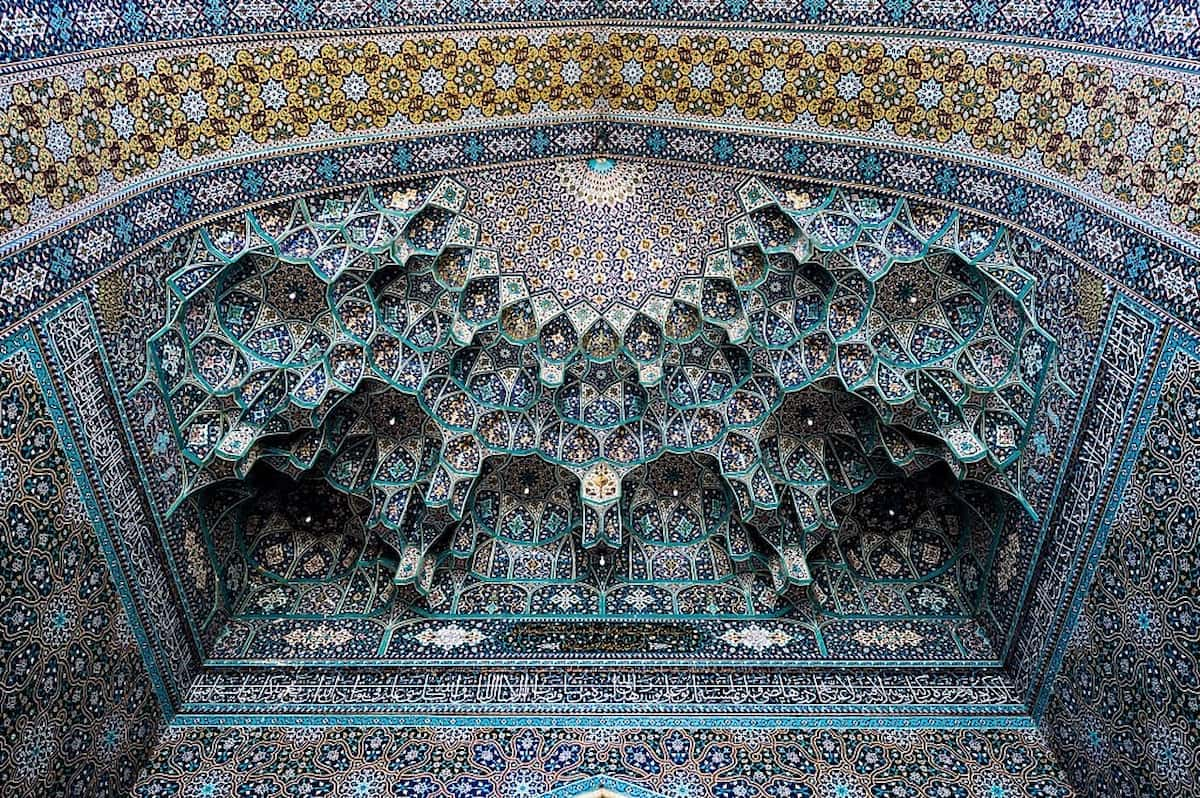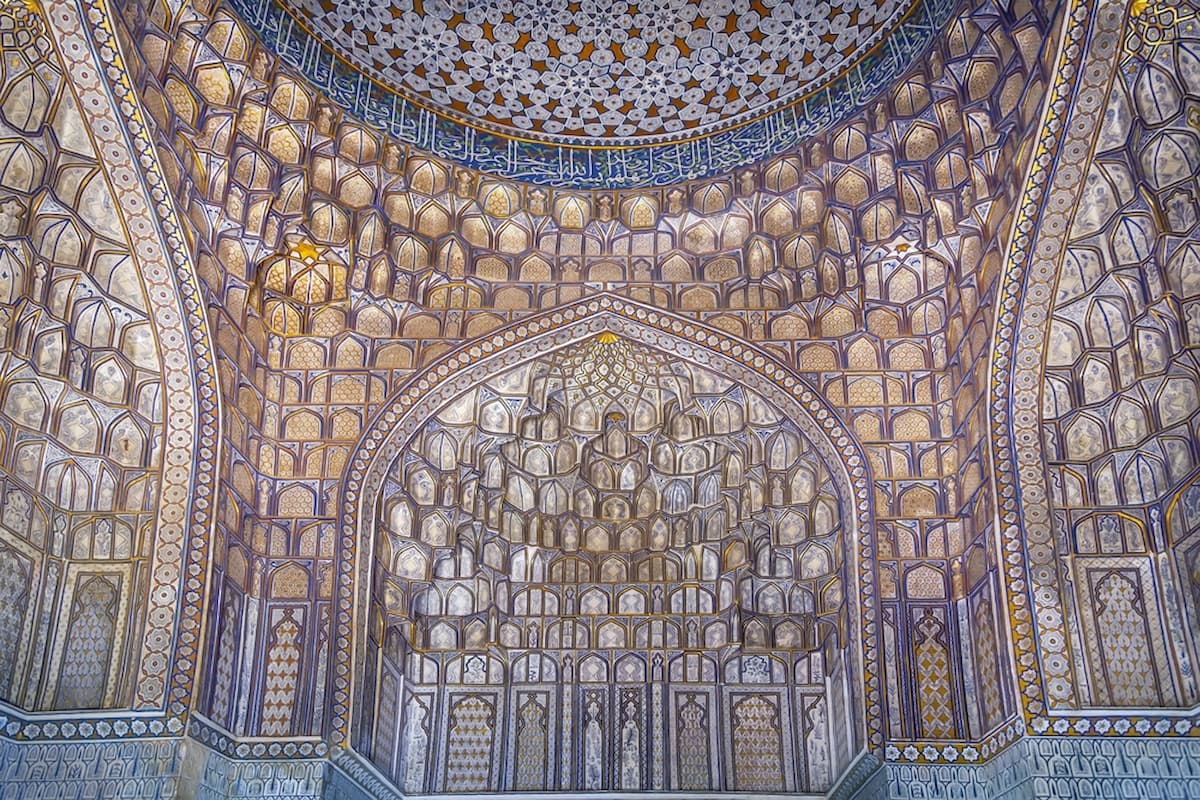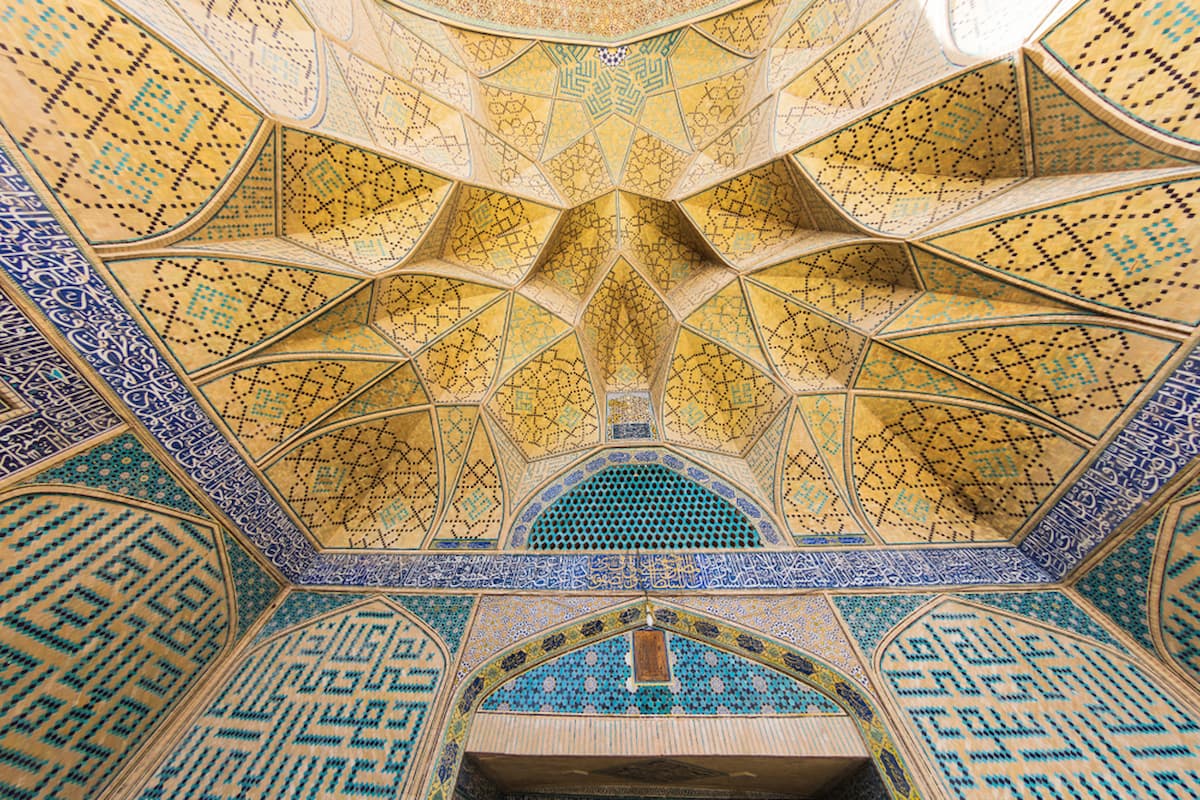Table of Contents
ToggleMuqarnas or Ahoopa (in Persian), an intricate architectural ornamentation, holds a significant place in Islamic-era architecture, captivating the eyes and minds of admirers for centuries. Derived from the word Karniz in old Pahlavi Persian or the Arabic word “qarn” meaning horn, muqarnas refers to a decorative technique that creates stunning three-dimensional geometric patterns. This unique feature has become an iconic symbol of Islamic-era art and is found in numerous mosques, palaces, and other structures across the Islamic world.
What is Muqarnas architecture?
Muqarnas is more than just an ornamental element; it serves as a testament to the extraordinary craftsmanship and mathematical precision of Islamic artisans. It showcases the seamless fusion of artistic expression, architectural innovation, and spiritual symbolism. From its historical origins to its contemporary adaptations, muqarnas has left an indelible mark on Islamic-era architecture and continues to inspire architects, artists, and scholars alike.
In this article, we will delve into the rich history, architectural features, symbolic meanings, and notable examples of muqarnas. We will also explore its practical functions, contemporary uses, and the challenges involved in its preservation. Join us on a captivating journey into the captivating world of muqarnas, where art, science, and spirituality intertwine in harmonious splendor.

Muqarnas art history definition
The origins of muqarnas can be traced back to the early centuries of Islamic civilization, drawing inspiration from diverse cultural and architectural influences. It emerged during the medieval Islamic period and flourished across regions such as the Middle East, North Africa, and Spain.
The development of muqarnas can be attributed to the ingenuity of Islamic-era architects and craftsmen who sought to push the boundaries of architectural design. They combined elements from Persian, Byzantine, and Roman traditions, infusing them with their unique aesthetics.
Muqarnas reached its zenith during the Islamic Golden Age, from the 9th to the 14th century, as architectural marvels like the Alhambra in Granada and the Samanid mausoleum in Bukhara showcased its intricate beauty. Architects and artisans perfected the art of geometric patterning and complex interlocking structures, resulting in breathtaking muqarnas compositions.
Over time, muqarnas underwent stylistic variations, influenced by the artistic tastes and regional preferences of different Islamic dynasties. It became a symbol of cultural identity and architectural excellence, leaving an enduring legacy that continues to inspire and captivate audiences to this day.

Read more: muqarnas architecture
Architectural Features of Muqarnas
Muqarnas is characterized by its remarkable three-dimensional geometric patterns and intricate structural design. It is a testament to the ingenuity and craftsmanship of Islamic-era architects and artisans. Here are some key architectural features of muqarnas:
- Three-Dimensional Geometric Patterns: Muqarnas structures consist of a series of tiered niches, each resembling a concave or honeycomb-like shape. These niches are meticulously arranged to create an illusion of depth and complexity, resulting in an awe-inspiring visual effect.
- Interlocking Elements: The individual niches of muqarnas seamlessly interlock with each other, forming a harmonious composition. The interplay of light and shadow further enhances the sense of depth and intricacy.
- Multiple Materials and Techniques: Muqarnas can be crafted using various materials such as stone, brick, plaster, or wood, depending on the architectural context and regional traditions. These materials are meticulously carved, molded, or assembled to achieve the desired geometric forms.
- Integration with Other Architectural Elements: Muqarnas is often integrated with other architectural features, such as arches, domes, and ceilings, creating a cohesive design language. It adds a sense of grandeur and refinement to the overall architectural composition.
The architectural features of muqarnas exemplify the mastery of Islamic artisans in combining mathematical precision, artistic finesse, and structural innovation, resulting in architectural marvels that continue to captivate and inspire generations.

Symbolism and Meaning
Beyond its architectural beauty, muqarnas carries rich symbolism and meaning in Islamic culture. It serves as a visual representation of the intricate relationship between the earthly and the divine. The geometric patterns of muqarnas reflect the order and harmony found in the natural world, while also symbolizing the underlying unity and perfection of God’s creation.
Moreover, muqarnas motifs often draw inspiration from Islamic calligraphy, Quranic verses, and geometric symbolism, infusing the ornamentation with spiritual significance. The interlocking niches can represent the interconnectedness of all aspects of creation and the complexity of the human experience.
Muqarnas, therefore, goes beyond its decorative function, acting as a powerful visual language that embodies Islamic philosophy, spirituality, and the pursuit of divine beauty in architectural form.
What is muqarnas in Islamic-era architecture?
Muqarnas is a unique architectural element found in Islamic architecture that is characterized by its intricate geometric design and three-dimensional composition. It is a decorative technique used to create ornamental vaulted structures, typically found in the ceilings, domes, and entrance portals of mosques, palaces, and mausoleums.
The word “muqarnas” is derived from the Arabic word “qarn,” meaning horn or stalactite, which reflects the shape and appearance of this architectural feature. Muqarnas consists of a series of tiered, projecting elements that are layered on top of each other, creating a honeycomb-like structure. These elements can be in the form of stalactite-like pendants, small arches, or intricate geometric patterns.
The primary purpose of muqarnas is decorative, adding an exquisite and mesmerizing aesthetic to the architectural space. It showcases the craftsmanship and mathematical precision prevalent in Islamic art and architecture. Muqarnas can be found in various forms and scales, ranging from small decorative details to elaborate and expansive vaulted ceilings.
Beyond its decorative function, muqarnas also serves an architectural purpose. It helps in distributing the weight and stress of the ceiling or dome, allowing for the creation of larger and more intricate architectural forms. It also provides a smooth transition between different architectural elements, enhancing the visual flow and continuity of the space.
Muqarnas is a testament to the advanced architectural and artistic skills of craftsmen in Islamic civilization. Its intricate geometry and mesmerizing design have made it an iconic feature of Islamic architecture, capturing the awe and admiration of visitors and scholars alike.
Muqarnas can be found in numerous iconic structures across the Islamic world, showcasing its exquisite beauty and architectural significance. Here are a few notable examples:
- Alhambra, Granada, Spain: The Nasrid Palaces within the Alhambra complex feature mesmerizing muqarnas compositions, adorning ceilings, arches, and domes.
- Shah Mosque, Isfahan, Iran: The magnificent dome of the Shah Mosque boasts intricate muqarnas designs, highlighting the mastery of Persian artisans in geometric patterning.
- Al-Azhar Mosque, Cairo, Egypt: The minaret of Al-Azhar Mosque showcases a stunning muqarnas balcony, adding an ornamental touch to the architectural ensemble.
- Topkapi Palace, Istanbul, Turkey: The palace’s Harem section includes impressive muqarnas ceilings, reflecting the grandeur of Ottoman architectural craftsmanship.
These examples exemplify the widespread use and enduring beauty of muqarnas, illustrating its integral role in Islamic architectural heritage.
Read more: persian tile work
Functions and Practical Considerations
Muqarnas serves several functions and practical considerations within Islamic architecture. Structurally, it provides support and reinforcement, distributing weight and enhancing the stability of architectural elements like domes and vaults. Its interlocking design improves structural integrity by evenly distributing loads.
Acoustically, muqarnas contributes to sound diffusion and control. The intricately designed niches and cavities help diffuse sound waves, reducing echoes and creating a more balanced and immersive auditory experience within spaces like mosques.
In terms of lighting, muqarnas plays a significant role in manipulating light within architectural spaces. The recessed niches and intricate surfaces interact with natural or artificial light sources, creating mesmerizing patterns of light and shadow. This interplay adds depth, texture, and visual interest, enhancing the overall ambience of the space.
Moreover, muqarnas serves ornamental and aesthetic functions, embellishing ceilings, arches, and surfaces with its intricate geometric patterns. It adds a touch of grandeur, refinement, and artistic beauty, elevating the visual appeal of the architecture.
Contemporary Uses and Adaptations
While muqarnas has its historical roots in Islamic architecture, its influence has transcended time and continues to inspire contemporary architects and designers. In modern times, muqarnas has found new applications and adaptations in architectural projects and decorative arts.
Contemporary architects often draw inspiration from the intricate geometric patterns of muqarnas to create innovative designs that pay homage to Islamic heritage. These designs may incorporate muqarnas-like structures, using modern materials and construction techniques while maintaining the essence of the traditional form.
Moreover, muqarnas motifs have been reimagined and applied to various mediums beyond architecture. They can be found in interior design, furniture, textiles, ceramics, and even digital art, showcasing the versatility and adaptability of this ornamental tradition.
The contemporary use and adaptation of muqarnas demonstrate its enduring influence and relevance in the world of design and art. It serves as a bridge between the past and the present, showcasing the timeless beauty and cultural significance of this iconic architectural feature.
Preservation and Conservation
Preserving and conserving muqarnas structures present significant challenges due to their delicate nature and the passage of time. Efforts are made to safeguard and restore these architectural treasures to ensure their longevity and cultural significance.
Conservation initiatives focus on documenting and analyzing existing muqarnas structures, understanding their construction techniques, and identifying areas of deterioration or damage. Skilled artisans and restoration experts employ traditional methods and materials to meticulously repair and replace damaged or decayed sections, ensuring the integrity of the original design.
Conservation projects also emphasize the importance of maintaining the environmental conditions surrounding muqarnas structures. Controlling humidity, temperature, and exposure to natural elements helps prevent further deterioration and ensures the longevity of these intricate architectural features.
Education and public awareness play a vital role in the preservation of muqarnas. By promoting the cultural value and significance of these structures, efforts are made to raise awareness among local communities, visitors, and authorities to foster a sense of responsibility and commitment to their protection.
Through ongoing preservation and conservation efforts, the beauty and historical significance of muqarnas continues to be safeguarded, ensuring that future generations can appreciate and learn from these remarkable examples of Islamic architectural heritage.
The following video is related to the design and construction of a 3D muqarnas that I prepared for the Istanbul Technical University workshop.
Conclusion
Muqarnas, with its intricate three-dimensional geometric patterns, holds a prominent place in Islamic architecture, capturing the imagination and admiration of beholders for centuries. Its historical origins, architectural features, symbolic meanings, and examples in iconic structures showcase its enduring significance and aesthetic appeal.
Beyond its artistic beauty, muqarnas serves practical functions such as structural support, acoustic enhancement, and light manipulation. It seamlessly combines utilitarian considerations with ornamental enrichment, exemplifying the ingenuity and purposeful design of Islamic architecture.
Moreover, muqarnas continues to inspire contemporary architects and designers, finding new applications and adaptations in modern projects and decorative arts. It serves as a bridge between the past and the present, preserving and reinterpreting the rich cultural heritage of Islamic art and architecture.
Muqarnas stands as a testament to the intersection of mathematics, artistry, and spirituality, leaving an indelible mark on Islamic architectural heritage, and reminding us of the power of human creativity and expression in shaping our built environment.
FAQ about muqarnas
What is the significance of muqarnas in Islamic architecture?
Muqarnas serves both decorative and functional purposes in Islamic architecture. It adds intricate beauty and visual appeal to the interior spaces, creating a sense of awe and spirituality. Functionally, muqarnas helps distribute the weight of ceilings and domes, allowing for the construction of larger and more complex architectural forms.
How is muqarnas constructed?
Muqarnas is constructed using a layered approach. Craftsmen carefully carve or mold individual elements, often made of plaster, stone, or wood, in geometric shapes. These elements are then assembled and stacked, creating the characteristic honeycomb-like structure. The level of complexity varies, ranging from simple decorative details to elaborate and ornate configurations found in monumental structures.

6 Responses
I am a student in Morocco and this article really helped me. I just wanted to thank you.
You’re very welcome Robin! I’m glad to hear that the article was helpful to you.
I live in Kuwait and I love to visit Iran and these art and architecture some day. thank you for the amazing content.
You’re very welcome! It is a pleasure to hear that you are enjoying the content on this site Muhammad. It would be an enriching and memorable journey if you had the opportunity to visit Iran and experience its captivating art and architecture firsthand.
انا طالبة من فلسطين هذا مقال جدا رائع، لكن هل من الممكن ان تتحدث عن قياسات و أبعاد قطع المقرنص والنسب الخاصه بالقطع ؟ لنتمكن من صناعت نموذج
You’re welcome! I appreciate the suggestion and will definitely check out the articles on your website about Muqarnas. It’s always great to have additional resources and information on this fascinating topic. Even if I don’t find exactly what I’m looking for, I’m sure the articles will be informative and interesting. Thank you for offering to update them when you have the time, that’s very kind of you.
https://saeidshakouri.com/muqarnas/
https://saeidshakouri.com/what-type-of-architecture-uses-muqarnas/